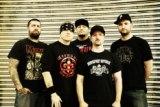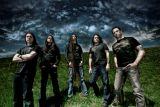THE EVOLUTION OF MUSIC PART-XX
METALCORE
Metalcore is a subgenre of heavy metal music combining various elements of extreme metal and hardcore punk. The name of it is a portmanteau of the names of the two genres. The term took on its current meaning in the mid-1990s, describing bands such as Earth Crisis, Deadguy and Integrity. The earliest of these groups, Integrity, began performing in 1988; some modern practitioners of the genre include Killswitch Engage,
Underoath, All That Remains, As I Lay Dying and The Devil Wears Prada. Metalcore is distinguished from other punk metal fusions by its emphasis on breakdowns: slower, intense passages conducive to moshing. The genre has had a saturation of bands in the last five years. Sepultura has been credited to "lay the foundation" for the genre.
History
Precursors (1977–1984)
Black Flag and Bad Brains, among the originators of hardcore, admired and emulated Black Sabbath. British street punk groups such as Discharge and The Exploited also took inspiration from heavy metal. The Misfits put out the Earth A.D. album, becoming a crucial influence on thrash. Nonetheless, punk and metal cultures and music remained separate through the first half of the 1980s.
Crossover thrash (1984–1988)
Cross-pollination between metal and hardcore eventually birthed the crossover thrash scene, which gestated at a Berkeley club called Ruthie's, in 1984. The term "metalcore" was originally used to refer to these crossover groups. Hardcore punk groups Corrosion of Conformity, Dirty Rotten Imbeciles and Suicidal Tendencies played alongside thrash metal groups like Metallica and Slayer. This scene influenced the skinhead wing of New York hardcore, which also began in 1984, and included groups such as Cro-Mags, Murphy's Law, Agnostic Front and Warzone. The Cro-Mags were among the most influential of these bands, drawing equally from Bad Brains, Motörhead, and Black Sabbath. Cro-Mags also embraced straight edge and, surprisingly enough, Krishna consciousness. Other New York straight edge groups included Gorilla Biscuits, Crumbsuckers, and Youth of Today, who inaugurated the youth crew style. 1985 saw the development of the hardcore breakdown, an amalgamation of Bad Brains' reggae and metal backgrounds, which encouraged moshing. Agnostic Front's 1986 album Cause for Alarm, a collaboration with Peter Steele, was a watershed in the intertwining of hardcore and metal.
Metallic hardcore (1989–2000)
 Between 1989 and 1995, a new wave of hardcore bands emerged. These included Merauder, All Out War, Integrity, Biohazard, Earth Crisis, Converge, Shai Hulud, Starkweather, Judge, Strife, Rorschach, Vision of Disorder, and Hatebreed. Integrity drew influence primarily from the Japanese hardcore terrorism of GISM and the metal of Slayer, with more subtle elements of Septic Death, Samhain, Motörhead, and Joy Division. Earth Crisis, Converge, and Hatebreed borrowed from death metal. Shai Hulud's Hearts Once Nourished with Hope and Compassion and Earth Crisis's 1995 album Destroy the Machines was particularly influential. In guitarist Scott Crouse's words, “It was a very mixed reaction. I'm often quoted as saying that Earth Crisis was the first hardcore band with a metal sound. Of course we weren't the first, but I think we definitely took it to another level. We heard a lot of, 'These guys are trying to be Pantera,' which we all took as a great compliment!”
Between 1989 and 1995, a new wave of hardcore bands emerged. These included Merauder, All Out War, Integrity, Biohazard, Earth Crisis, Converge, Shai Hulud, Starkweather, Judge, Strife, Rorschach, Vision of Disorder, and Hatebreed. Integrity drew influence primarily from the Japanese hardcore terrorism of GISM and the metal of Slayer, with more subtle elements of Septic Death, Samhain, Motörhead, and Joy Division. Earth Crisis, Converge, and Hatebreed borrowed from death metal. Shai Hulud's Hearts Once Nourished with Hope and Compassion and Earth Crisis's 1995 album Destroy the Machines was particularly influential. In guitarist Scott Crouse's words, “It was a very mixed reaction. I'm often quoted as saying that Earth Crisis was the first hardcore band with a metal sound. Of course we weren't the first, but I think we definitely took it to another level. We heard a lot of, 'These guys are trying to be Pantera,' which we all took as a great compliment!”
Biohazard, Coalesce, and Overcast were also important early metalcore groups. These groups are sometimes referred to as "metallic hardcore".
Melodic metalcore (1995–present)
 In the early 1990s, a third wave of metalcore groups appeared, who placed significantly greater emphasis on melody. These bands combined more modern elements of punk and metal and tend to fuse melodic death metal and hardcore punk/post-hardcore, and in some examples the use of emo. The first bands to have blended such elements such as Avenged Sevenfold, Killswitch Engage, All That Remains, Shadows Fall, Unearth, Bleeding Through and Atreyu emerged and are now the most commercially successful practitioners of metalcore. These groups took major influence, cues, and writing styles from Swedish melodic death metal bands, particularly In Flames, Dark Tranquillity and At the Gates. Melodic metalcore frequently makes use of clean vocals, and is significantly less dissonant than other metalcore. Some of these groups, such as Shadows Fall, have voiced an affection for '80s glam metal. Melodic metalcore groups have been described as "embrac[ing] '80s metal clichés", such as "inordinate amounts of smoke machines, rippin' solos, [and] three bass drums".
In the early 1990s, a third wave of metalcore groups appeared, who placed significantly greater emphasis on melody. These bands combined more modern elements of punk and metal and tend to fuse melodic death metal and hardcore punk/post-hardcore, and in some examples the use of emo. The first bands to have blended such elements such as Avenged Sevenfold, Killswitch Engage, All That Remains, Shadows Fall, Unearth, Bleeding Through and Atreyu emerged and are now the most commercially successful practitioners of metalcore. These groups took major influence, cues, and writing styles from Swedish melodic death metal bands, particularly In Flames, Dark Tranquillity and At the Gates. Melodic metalcore frequently makes use of clean vocals, and is significantly less dissonant than other metalcore. Some of these groups, such as Shadows Fall, have voiced an affection for '80s glam metal. Melodic metalcore groups have been described as "embrac[ing] '80s metal clichés", such as "inordinate amounts of smoke machines, rippin' solos, [and] three bass drums".
Ideologies
Metalcore emerged from the milieu surrounding youth crew hardcore punk subculture, with many of the groups adhering to straight edge beliefs (abstention from drugs and alcohol), although Integrity was a notable exception. Converge was notable for their focus on personal anguish and experiences of failed romantic love. Dwid Hellion, frontman of Integrity, advocated the "Holy Terror Church of Final Judgment", an apocalyptic belief system related to Gnosticism and Catharism. Several members of contemporary metalcore bands are practicing Christians, including members of Zao, The Devil Wears Prada, As I Lay Dying, August Burns Red, Texas in July, Demon Hunter, Oh, Sleeper and Underoath.



